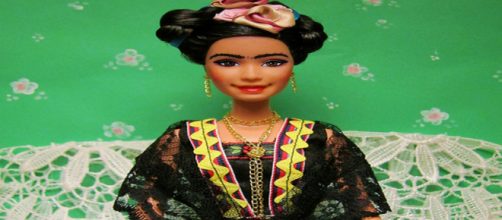Who doesn't know what Frida Kahlo looks like? Mattel, that's who, the company that makes Barbie dolls and now is is offering some sorry semblance of the artist. Despite her 50-plus self-portraits, which, by their sheer number leave an indelible imprint on our mind's eye, Mattel's version looks like Paris Hilton with her hair dyed black.
Kahlo was not one to toy with
Salma Hayek, who played Kahlo in the 2002's biopic "Frida," gave a two thumbs down in an Instagram saying, “Frida Kahlo never tried to be or look like anyone else. She celebrated her uniqueness.
How could they turn her into a Barbie?” Good question, when you consider that the artist was seen by Surrealist leader André Breton as a “ribbon around a bomb.”
A painter, not a puppet
Perhaps the biggest flaw in “Frida Barbie” is the facial expression – a silly grin. Kahlo was a serious artist, widely known for saying, “I am happy to be alive as long as I can paint.” She certainly didn't do much grinning, having sustained a crippling back injury from an accident in her teens. And she wanted people to know her pain. She gifted friends Lina and Arccady Boitie “Wounded Deer,” a self-portrait with the body of the animal pierced with arrows, saying, “I leave you my portrait so that you will have my presence all the days and nights that I am away from you.”
Where's the rest of me?
It's hard to find Kahlo's “presence” in a doll that looks like it hasn't a thought in its head, especially given her famous line, “The most important part of the body is the brain.” The artist's great-niece, Mara Romeo, told the press that she couldn't find her aunt in the toy figure and wants Mattel to retool it: “It should be a doll that represents everything my aunt represented, her strength.”
Merchandising men and women
Sad to say, “Frida Barbie” isn't the only product linked to her that belies who she was.
A few of the unlikely items included sneakers and beer. Granted, Kahlo isn't the only artist associated with inappropriate merchandise. Van Gogh's “Starry Night” comes in tote bags and lumbar pillows. And Da Vinci's “Mona Lisa” has been plastered on everything from flip flops to condoms. (It's notable that she was a mother of five and a devout Catholic).
Mattel mistake
Happily, not all products connected to Kahlo have been dishonoring. A U.S. Postal Service stamp bore her face in 2001 and images of her with her husband, muralist Diego Rivera, graced Mexican currency in 2010, not unlike the way American presidents are pictured on U.S. Currency. In its defense, Mattel Corp. said in a statement that the doll aimed “to conserves the essence of Barbie and the legacy of Frida Kahlo.” You can't have it both ways. The doll is simply a regulation Barbie in colorful clothes.


